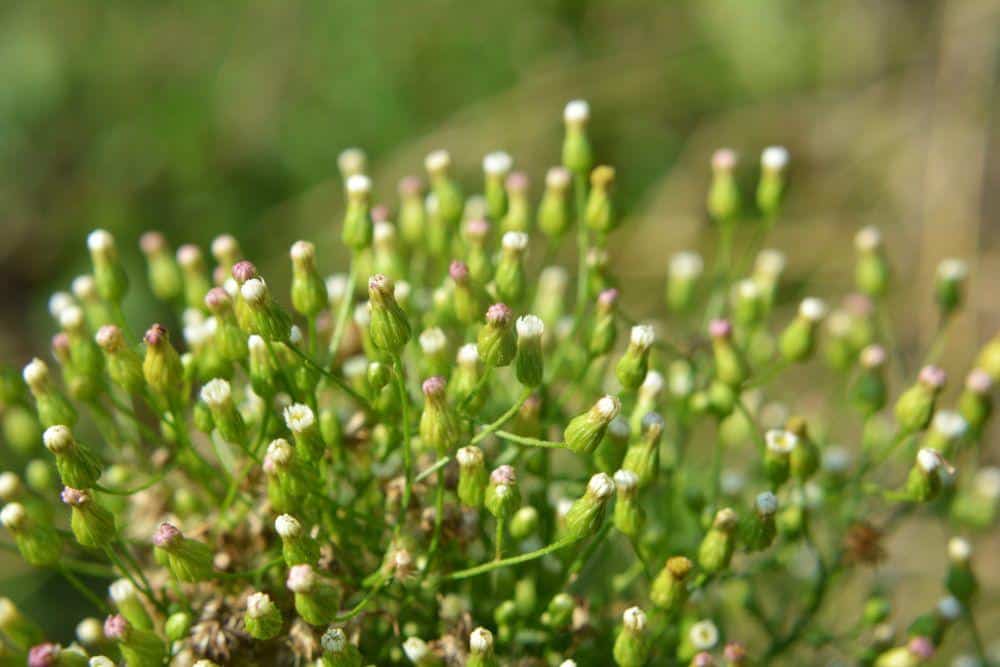Identification and Removal Guide for Austin Homeowners
Canadian horseweed, iis a notable weed in many regions. You will often find it in North America, where it is native. This plant belongs to the aster family (Asteraceae).
You can easily identify horseweed by its growth pattern. The plant starts as a rosette, which is a circular arrangement of leaves close to the ground. As it matures, it bolts, or grows taller, producing a single tall stem. The small, white flower heads appear later, often in clusters.
Canadian horseweed is an annual weed. Its life cycle completes in one year. Early detection is crucial. Complicating matters is that seed production is prolific. Each plant produces thousands of tiny seeds. These seeds spread by wind, making control difficult.
Identifying the Problem
A Gardener Helps You to Identify Horseweed on Your Property
Physical Characteristics
Horseweed grows up to 5 feet tall with a single, hairy stem. The leaves are narrow, often with a toothed margin, arranged in a spiral around the stem. White flowers appear in clusters at the top. The plant can re-sprout from broken stems, making full removal crucial. Horseweed has a deep taproot system. This root structure supports its fast growth and resilience.

What Canadian Horseweed Looks Like
Horseweed Habitats
Horseweed thrives in various settings, including agricultural fields, roadside areas, and lawns. It flourishes in disturbed soils and places where land management is minimal. The seeds spread easily through the wind, making it adaptable to different environments – and making it easy for horseweed to establish itself in vulnerable places on your property .
Pay attention to disturbed areas on your property – especially areas where grass is sparse and has a tough time taking root. This could represent an opportunity for horseweed and other invasive weeds.
Preventative Measures
Effective control of Canadian Horseweed requires a mix of cultural techniques and limiting seed dispersal to manage and prevent future infestations.
Mechanical Control Methods
Consider mechanical control methods if possible to avoid potential negative effects of pesticides. They provide an effective alternative, especially for organic gardens and lawns.
Preventing Horseweed in Your Lawn
Dense Healthy Lawns Prevent Weeds – Keep your lawn dense and thick if possible. A healthy, thick, dense lawn doesn’t provide an easy opportunity for weeds – including horseweed – to take hold.
Mowing Practices – Mowing horseweed regularly before it matures can prevent seed production. This method controls the spread and establishment of the weed. Hand pulling can be effective for small infestations. You must remove the entire plant, including roots, to stop regrowth. If you can’t easily pull up the entire plant, tilling it may help. Tillage works by burying horseweed seeds, which need light to germinate. Even shallow tillage can significantly reduce germination rates.
Preventing Horseweed in Planting Areas
Make sure planting areas have a thick layer of mulch on top of a layer of landscape fabric to deter horseweed from getting established.

Monitoring your lawn and pulling weeds – as well as maintaining a dense lawn can help to prevent horseweed and other weeds from getting established on your property
Chemical Management of Horseweed
Chemical control of Canadian horseweed involves using targeted herbicides. Proper understanding and application can restore herbicide efficacy, and various options are available to tackle glyphosate-resistant strains.
Understanding Herbicides
Herbicides remain a key (but increasingly less effective) component in controlling horseweed. Commonly used products include glyphosate and 2,4-D, known for their effectiveness. Unfortunately, glyphosate is proving to be less effective as of late as Canadian Horseweed is oftentimes resistant.
Frequently Asked Questions
What natural methods are effective for controlling Canadian horseweed?
Tillage helps manage horseweed by burying its seeds. Mulching prevents germination by smothering seeds with a layer of organic material. Both methods can reduce the spread of horseweed. Consistent mowing and a dense lawn can also help to keep horseweed in check.
Can vinegar be used as an herbicide for horseweed, and how effective is it?
While vinegar can kill young horseweed plants, it will likely require concentrations greater than what you have in your kitchen unless you’re able to apply it to the horseweed during the first two weeks of life (very young plants only). You’ll want to ensure you thoroughly cover the plants and it may require multiple applications. Note that high concentrations of vinegar can be dangerous to humans and animals, so you’ll want to do your research before using vinegar as part of your weed control efforts.
Is it necessary to remove horseweed, and what are the reasons for its removal from residential areas?
Horseweed competes with desirable plants for nutrients and water. Its removal improves the health of your lawn and garden. It can also reduce the spread of this aggressive weed to neighboring properties.